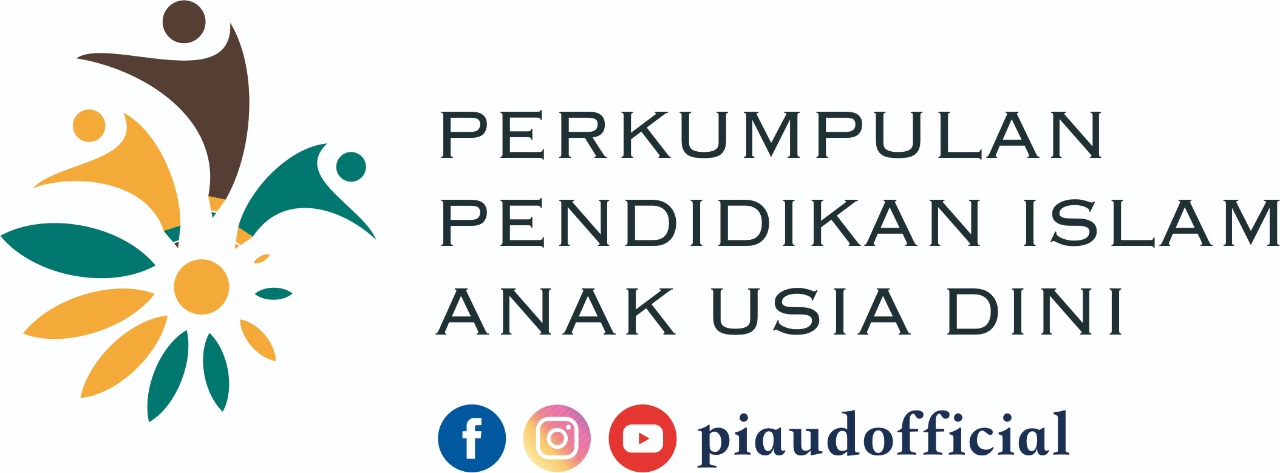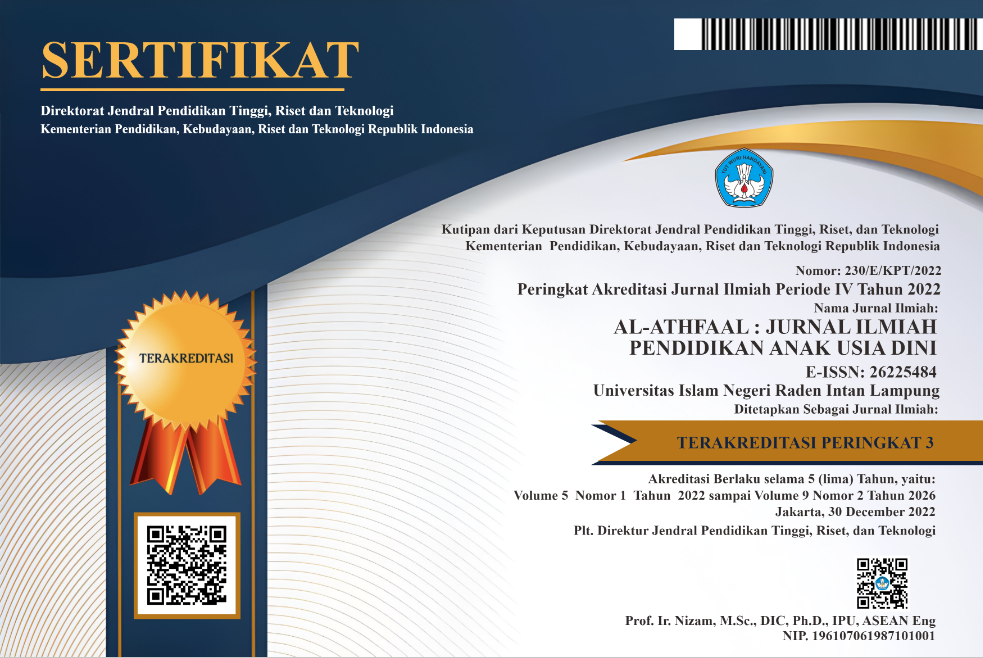The influence of school culture and self-esteem on the character of early childhood teachers
Abstract
This study aims to determine how much influence Early Childhood teachers’ self-esteem on character, the influence of school culture on the character of Early Childhood Teachers, and the influence of self-esteem and school culture on the character of Early Childhood Teachers. To obtain the data using a questionnaire. The type of research is a quantitative explanatory approach. Data analysis was performed by multiple regression analysis. The results of data analysis show the Pearson correlation value of self-esteem (X1) with the character of early childhood teachers (Y) of 0.576. It shows that the strength of the relationship between self-esteem (X1) and the character of early childhood teachers (Y) is in the moderate category. Furthermore, the Pearson correlation value of school culture (X2) with the character of early childhood teachers (Y) is 0.793. It shows that the strength of the relationship between school culture (X2) and the character of early childhood teachers (Y) is included in the strong category. The double correlation of X1 and X2 with Y is significant. It means there is an effect of self-esteem and school culture on the character of early childhood teachers. Furthermore, the Pearson correlation value is 0.828. It shows that the strength of the relationship between self-esteem (X1) and school culture (X2) with the character of early childhood teachers (Y) is included in the very strong category. The product-moment correlation between X1 and X2 with Y (Ryx1x2) is 0.828. It means that self-esteem and school culture affect the personality of Early Childhood Teachers, which is the research's novelty.
Keywords
Full Text:
PDFReferences
Balkar, B. (2015). Defining an empowering school culture (ESC): Teacher perceptions. Issues in Educational Research, 25(3), 205–224.
Bandura, A. (2009). Social cognitive theory of mass communication. In Media effects (pp. 110–140). Routledge.
Barrow, G., Bradshaw, E., & Newton, T. (2012). Improving behaviour and raising self-esteem in the classroom: A practical guide to using transactional analysis. David Fulton Publishers.
Baumeister, R. F., & Masicampo, E. J. (2010). Conscious thought is for facilitating social and cultural interactions: How mental simulations serve the animal–culture interface. Psychological Review, 117(3), 945.
Branden, N. (1995). The six pillars of self-esteem. Bantam Doubleday Dell Publishing Group Incorporated.
Branden, N. (2011). How to raise your self-esteem: the proven action-oriented approach to greater self-respect and self-confidence. Bantam.
Branden, N. (2021). The power of self-esteem. Health Communications, Inc.
Brownfain, J. J. (1952). Stability of the self-concept as a dimension of personality. The Journal of Abnormal and Social Psychology, 47(3), 597.
Cahyono, A. D. (2020). Implementasi Budaya Sekolah Dalam Mengembangkan Sikap Disiplin Siswa MI Mamba’ul Huda Al-Islamiyah Ngabar Siman Ponorogo. IAIN Ponorogo.
Cast, A. D., & Burke, P. J. (2002). A theory of self-esteem. Social Forces, 80(3), 1041–1068.
Crocker, J., & Major, B. (1989). Social stigma and self-esteem: The self-protective properties of stigma. Psychological Review, 96(4), 608.
Damsy, Y. J., & Rivaei, W. (2014). Peran Orang Tua dan Guru dalam Mengatasi Sikap dan Perilaku Menyimpang Anak. Jurnal Pendidikan Dan Pembelajaran Khatulistiwa, 3(2).
Deal, T. E., & Peterson, K. D. (1990). The principal’s role in shaping school culture. US Department of Education, Office of Educational Research and Improvement.
Deal, T. E., & Peterson, K. D. (1999). Shaping school culture: The heart of leadership. Adolescence, 34(136), 802.
Deal, T. E., & Peterson, K. D. (2016). Shaping school culture. John Wiley & Sons.
Dhofir, M. (2018). Karakter Guru Profesional. TARBAWI. Jurnal Studi Pendidikan Islami, 5(01).
Donaldson, G. (2006). Cultivating leadership in schools: Connecting people, purpose, and practice. Teachers College Press.
Erickson, F. (1987). Conceptions of school culture: An overview. Educational Administration Quarterly, 23(4), 11–24.
Erozkan, A., Dogan, U., & Adiguzel, A. (2016). Self-Efficacy, Self-Esteem, and Subjective Happiness of Teacher Candidates at the Pedagogical Formation Certificate Program. Journal of Education and Training Studies, 4(8), 72–82.
Fatimaningrum, A. S. (2011). Karakteristik Guru Dan Sekolah Yang Efektif Dalam Pembelajaran. Majalah Ilmiah Pembelajaran, 7(2).
Finnis, J. (2005). Aquinas’ moral, political, and legal philosophy.
Fitts, W. H. (1971). The self-concept and self-actualization. Studies on the Self Concept.
Fox, K. R., & Magnus, L. (2014). Self-esteem and self-perceptions in sport and exercise. In Routledge companion to sport and exercise psychology (pp. 34–48). Routledge.
Frey, D., & Carlock, C. J. (1989). Enhancing self esteem. ERIC.
Griswold, W. (2012). Cultures and societies in a changing world. Sage.
Hamzah, R. F. (n.d.). MENINGKATKAN KOMPETENSI GURU SEKOLAH DASAR DALAM RANGKA MENGHADAPI PEMBELAJARAN DI ABAD KE-21.
Hargreaves, D. (2012). The challenge for the comprehensive school: culture, curriculum and community. Routledge.
Hay, I., Ashman, A. F., & Van Kraayenoord, C. E. (1998). Educational characteristics of students with high or low self‐concept. Psychology in the Schools, 35(4), 391–400.
Hewitt, J. P. (2020). 22 The Social Construction of Self-Esteem. The Oxford Handbook of Positive Psychology, 309.
Ikhsan, M. A. (n.d.). MENJADI GURU KREATIF DAN INOVATIF.
Jerald, C. D. (2006). School culture. Center for Comprehensive School Reform and Improvement.
Kandiri, K., & Arfandi, A. (2021). GURU SEBAGAI MODEL DAN TELADAN DALAM MENINGKATKAN MORALITAS SISWA. Edupedia: Jurnal Studi Pendidikan Dan Pedagogi Islam, 6(1), 1–8.
Kelley, H. H., & Stahelski, A. J. (1970). Social interaction basis of cooperators’ and competitors’ beliefs about others. Journal of Personality and Social Psychology, 16(1), 66.
Khusnah, W. (2020). PENGARUH BUDAYA SEKOLAH DAN KOMPETENSI KEPRIBADIAN GURU TERHADAP KARAKTER SISWA KELAS V SD DABIN 1 KECAMATAN TALANG KABUPATEN TEGAL.
Lickona, T. (2004). Character matters: How to help our children develop good judgment, integrity, and other essential virtues. Simon and Schuster.
Lickona, T. (2012). Character education: Restoring virtue to the mission of schools. In Developing Cultures (pp. 57–76). Routledge.
Lifshitz, H., Hen, I., & Weisse, I. (2007). Self-concept, adjustment to blindness, and quality of friendship among adolescents with visual impairments. Journal of Visual Impairment & Blindness, 101(2), 96–107.
Manfredo, M. J., Bruskotter, J. T., Teel, T. L., Fulton, D., Schwartz, S. H., Arlinghaus, R., … Kitayama, S. (2017). Why social values cannot be changed for the sake of conservation. Conservation Biology, 31(4), 772–780.
Mann, M. M., Hosman, C. M. H., Schaalma, H. P., & De Vries, N. K. (2004). Self-esteem in a broad-spectrum approach for mental health promotion. Health Education Research, 19(4), 357–372.
Maryamah, E. (2016). Pengembangan Budaya Sekolah. Tarbawi: Jurnal Keilmuan Manajemen Pendidikan, 2(02), 86–96.
Maya, R. (2017). Esensi Guru dalam Visi-Misi Pendidikan Karakter. Edukasi Islami: Jurnal Pendidikan Islam, 2(03).
Mbuva, J. (2016). Exploring teachers’ self-esteem and its effects on teaching, students’ learning and self-esteem. Journal of Higher Education Theory and Practice, 16(5), 59.
Nasional, D. P. (2010). Rencana Strategis Departemen Pendidikan Nasional Tahun 2010-2014. Jakarta: Departemen Pendidikan Nasional.
Nasution, K. (2021). Hubungan Budaya Sekolah Dan Keteladanan Guru Dengan Karakter Siswa Sekolah Dasar Negeri 050772 Kecamatan Pangkalan Susu Kabupaten Langkat. Jurnal Analisa Pemikiran Insan Cendikia (Jurnal APIC), 4(1), 19–26.
Nata, A. (2021). Pendidikan Karakter Untuk Menjawab Tantangan Abad Ke-21. Abuddin Nata.
Nizary, M. A., & Hamami, T. (2020). Budaya Sekolah. At-Tafkir, 13(2), 161–172.
Orth, U., & Robins, R. W. (2014). The development of self-esteem. Current Directions in Psychological Science, 23(5), 381–387.
Pahl-Wostl, C., Tàbara, D., Bouwen, R., Craps, M., Dewulf, A., Mostert, E., … Taillieu, T. (2008). The importance of social learning and culture for sustainable water management. Ecological Economics, 64(3), 484–495.
Pajares, F. (2006). Self-efficacy during childhood and adolescence. Self-Efficacy Beliefs of Adolescents, 5, 339–367.
Perkins, J. (2022). Social, Legal, and Moral Norms. Available at SSRN.
Peterson, K. D., & Deal, T. E. (2009). The shaping school culture fieldbook. John Wiley & Sons.
Pratiwi, W. E. (2014). Pengaruh budaya Jawa dan harga diri terhadap Asertivitas pada remaja siswa kelas X di SMA Negeri 3 Ponorogo. Psikoborneo: Jurnal Ilmiah Psikologi, 2(3).
Ratnawati, R. (2018). Peranan guru sebagai model dalam pembentukan Karakter peserta didik. Prosiding Seminar Nasional Pendidikan.
Rosenstock, I. M. (1974). Historical origins of the health belief model. Health Education Monographs, 2(4), 328–335.
Rubio, F. D. (2014). Self-esteem and self-concept in foreign language learning. Multiple Perspectives on the Self in SLA, 4158.
Ryan, R. M., Stiller, J. D., & Lynch, J. H. (1994). Representations of relationships to teachers, parents, and friends as predictors of academic motivation and self-esteem. The Journal of Early Adolescence, 14(2), 226–249.
Sari, D. & I. P. (2014). Karakteristik Guru Ideal.
Schoen, L. T., & Teddlie, C. (2008). A new model of school culture: A response to a call for conceptual clarity. School Effectiveness and School Improvement, 19(2), 129–153.
Sinabariba, R. B. (2017). Peranan guru memilih model-model pembelajaran untuk meningkatkan kemampuan menulis puisi.
Stiegelbauer, S. (1992). Why We Want To Be Teachers: New Teachers Talk about Their Reasons for Entering the Profession.
STOLP, S., & SMITH, S. C. (1998). School culture.
Stolp, S. W. (1994). Leadership for school culture.
Suryana, D. (2016). Pendidikan Anak Usia Dini: Stimulasi & Aspek Perkembangan Anak. Prenada Media.
Suryana, D. (2021). Pendidikan anak usia dini teori dan praktik pembelajaran. Prenada Media.
Van der Linden, S. (2011). Charitable intent: A moral or social construct? A revised theory of planned behavior model. Current Psychology, 30(4), 355–374.
Wiener, Y. (1982). Commitment in organizations: A normative view. Academy of Management Review, 7(3), 418–428.
Williams Jr, R. M. (1979). Change and stability in values and value systems: A sociological perspective. Understanding Human Values, 15, 46.
Wlodkowski, R. J., & Ginsberg, M. B. (2017). Enhancing adult motivation to learn: A comprehensive guide for teaching all adults. John Wiley & Sons.
Wuthnow, R. (1995). Learning to care: Elementary kindness in an age of indifference. Oxford University Press.
Zeigler-Hill, V. (2013). Self-esteem. Psychology Press.
DOI: http://dx.doi.org/10.24042/ajipaud.v5i2.13753
Refbacks
- There are currently no refbacks.
Copyright (c) 2022 Al-Athfaal: Jurnal Ilmiah Pendidikan Anak Usia Dini
License URL: https://creativecommons.org/licenses/by-sa/4.0
 Semua publikasi Al-Athfaal: Jurnal Ilmiah Pendidikan Anak Usia Dini [p-ISSN: 2622-5484, e-ISSN: 2622-5182] dilisensikan di bawah Lisensi Internasional Creative Commons Atribusi-BerbagiSerupa 4.0.
Semua publikasi Al-Athfaal: Jurnal Ilmiah Pendidikan Anak Usia Dini [p-ISSN: 2622-5484, e-ISSN: 2622-5182] dilisensikan di bawah Lisensi Internasional Creative Commons Atribusi-BerbagiSerupa 4.0.











